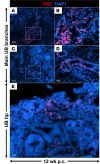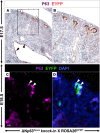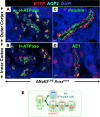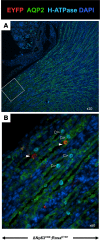p63+ ureteric bud tip cells are progenitors of intercalated cells
- PMID: 28469077
- PMCID: PMC5414549
- DOI: 10.1172/jci.insight.89996
p63+ ureteric bud tip cells are progenitors of intercalated cells
Abstract
During renal branching morphogenesis, ureteric bud tip cells (UBTC) serve as the progenitor epithelium for all cell types of the collecting duct. While the transcriptional circuitry of ureteric bud (UB) branching has been intensively studied, the transcriptional control of UBTC differentiation has been difficult to ascertain. This is partly due to limited knowledge of UBTC-specific transcription factors that mark the progenitor state. Here, we identify the transcription factor p63 (also known as TP63), a master regulator of basal stem cells in stratified epithelia, as a specific marker of mouse and human UBTC. Nuclear p63 marks Ret+ UBTC transiently and is silenced by the end of nephrogenesis. Lineage tracing revealed that a subset of UBTC expressing the ΔNp63 isoform (N-terminus truncated p63) is dedicated to generating cortical intercalated cells. Germline targeting of ΔNp63 in mice caused a marked reduction in intercalated cells near the time of birth, indicating that p63 not only marks UBTC, but also is essential for their differentiation. We conclude that the choice of UBTC progenitors to differentiate is determined earlier than previously recognized and that UBTC progenitors are prepatterned and fate restricted. These findings prompt the rethinking of current paradigms of collecting duct differentiation and may have implications for regenerative renal medicine.
Keywords: Development; Nephrology.
Conflict of interest statement
Figures









References
Grants and funding
LinkOut - more resources
Full Text Sources
Other Literature Sources

